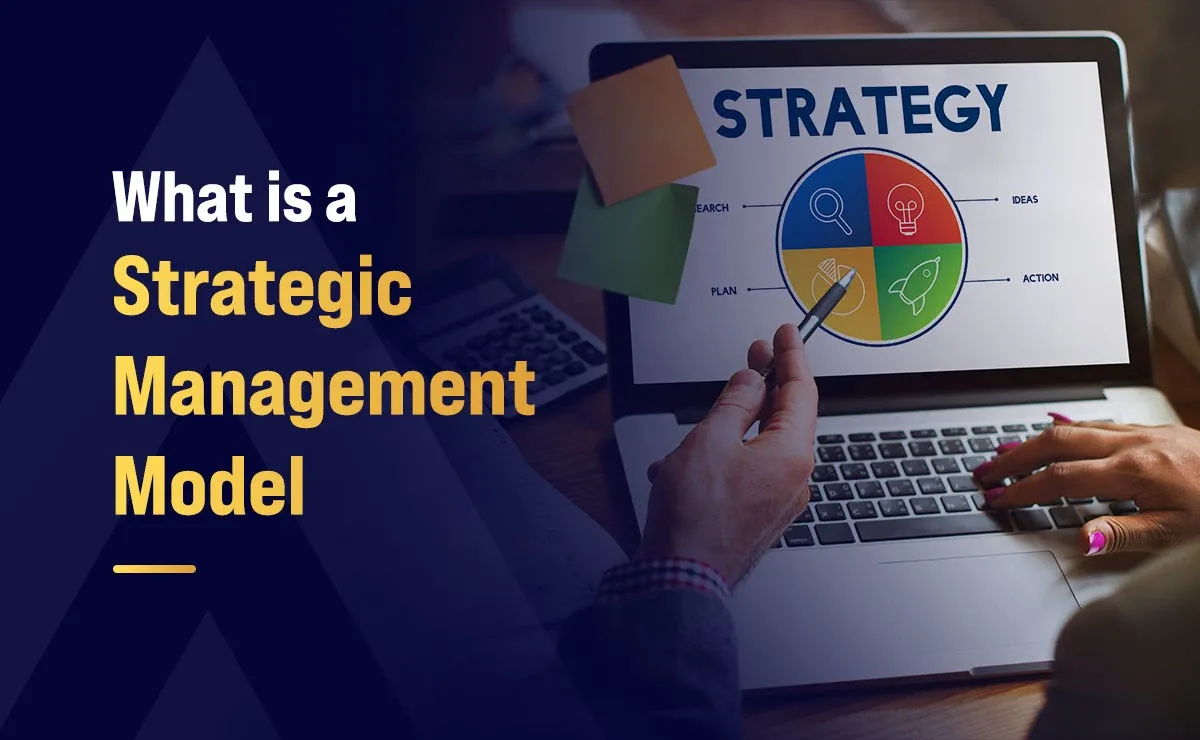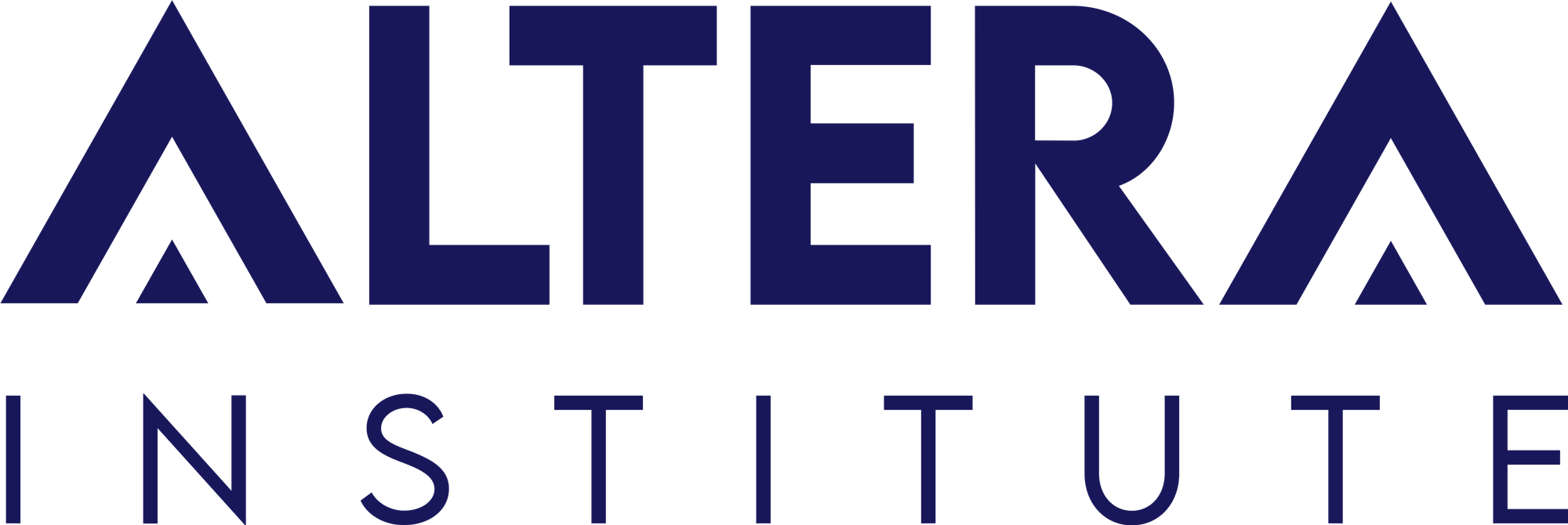What is a Strategic Management Model?

The strategic management model serves as a framework or template that helps organizations set goals, conduct environmental analysis, implement strategies, and evaluate performance.
To succeed in the ever-changing business world, an organization must create synergy among its people, systems, and processes to stay ahead of new trends.
This article explores the components, significance, and approaches of the strategic management model, offering a comprehensive understanding for students and professionals seeking to master this essential framework.
At Altera Institute, we believe strategy isn’t learned from textbooks alone—it’s built through experience. Our PGP programs integrate real-world business scenarios and strategic simulations, enabling students to develop the analytical thinking and leadership mindset necessary to make informed decisions.
What is a Strategic Management Model?
A strategic management model is an integrated framework that guides organizations through the analysis, planning, implementation, and evaluation of various strategies. It aims to optimize decision-making, resource allocation, and the achievement of long-term business objectives effectively.
The strategic management model guarantees a proactive response to any changing environment, innovation, competitive strength, strategic alignment, streamlined processes, promotion of stakeholder engagement, and long-term organizational growth and sustained performance.

Components of the Strategic Management Model
The strategic management model comprises interconnected components that guide organizations through the phases of crafting, executing, and evaluating strategies.
These components are also part of the strategic management model overview, which helps an organization ensure an organized approach to attaining its goals while adjusting to changing business needs.
Formulating Strategic Goals and Plans:
Strategy formulation creates the foundation for the realization of the vision and mission of the organization. Key activities include:
- Defining Vision and Mission: These statements establish the path and purpose of the organization, which then serve as a guide to all strategic endeavors of the organization.
- Setting Long-Term Objectives: A clear and quantifiable set of goals ensures that all activities are directed toward the overall scope of the organization and its ambitions.
- Analyzing Internal and External Environments: An audit, such as a SWOT analysis (Strengths, Weaknesses, Opportunities, and Threats), will help determine the possible benefits and threats.
- Selecting and Evaluating Strategies: This entails an evaluation of the different strategic alternatives and selection of the best to attain the targeted set goals.
Executing Strategies Effectively:
Strategic plans are transformed into actions during the implementation phase. The main aspects of this phase are:
- Handling Management Issues: This is achieved by streamlining leadership positions, organizational structures, and resource allocation, ensuring ease in transitioning between planning and action.
- Integrating Functional Areas: Coordinating operations within various functions, such as marketing, finance, R&D, and Information Technology, can ensure that each department plays a role in the success of the strategy.
Monitoring and Adjusting Strategic Plans:
Assessment is essential to prove that strategies are effective in achieving the desired results and maintain their relevance to the changing conditions. This involves:
- Measuring Results: Measuring results periodically and comparing them to previously established key performance indicators (KPIs) and the degree of effectiveness.
- Identifying Gaps and Refining Strategies: Addressing deviations between planned and actual outcomes through timely adjustments.
- Carrying out Competitor Analysis: Learning about market forces and competitive actions in order to keep up.
When applied to the strategic management system, these main aspects enable organizations to have a cohesive approach to accomplishing their objectives and remain flexible in an ever-changing business environment.
Business Ethics, Social Responsibility, and Environmental Sustainability
The strategic business model is superior, as it is oriented toward flexibility, alignment with the stakeholders, and making the company stand out in the competitive market. The integration of ethics, corporate social responsibility (CSR), and sustainability can be very effective in strengthening these attributes in order to make an enterprise more resilient, competitive, and purpose-driven.

We will begin by defining what business ethics, social responsibility, and environmental sustainability entail.
- Business Ethics: Business ethics are ethical codes that help in determining the organization's decision-making and behaviors. It enhances transparency, fairness, and accountability and maintains the trust of the stakeholders, as well as ensuring that their plans are consistent with the social standards and moral expectations. Therefore, ethical considerations in strategic planning provide profit at the moral level.
- Social responsibility: Corporate Social Responsibility (CSR) is not only about profit but also emphasizes the role of a company in making a positive contribution to society. These include community work, charity, and fair labor. Companies that focus on the issues of CSR tend to experience a higher level of brand loyalty and improved relations with the stakeholders.
- Environmental Sustainability: It deals with the minimization of the ecological footprint of a company and the maintenance of resources conducive to the next generation. The competitive advantage and consumer loyalty can be achieved because of strategies aimed at sustainability (e.g., a renewable energy source, waste minimization, and ecological product promotion).
These are elements in a strategic business that inform the strategy formulation, implementation, and evaluation processes by:
- Ensuring all strategic activities align with moral and societal expectations.
- CSR and sustainability initiatives strengthen the organization’s image and customer loyalty.
- Sustainable practices reduce risks and align with global trends, fostering resilience in a competitive market.
- Ethical practices and social responsibility foster trust and establish deeper, more meaningful relationships with employees, customers, and the broader community.
Five Forces Model in Strategic Management by Porter
Michael Porter is a renowned professor at Harvard Business School who developed the Five Forces model to assess the competitive forces in a given industry. The model brings five important elements that influence the ability of an organization to make a profit.
Competitive Rivalry:
This is the force that analyzes the level of competition in the industry. There is high rivalry that is characterized by a large number of competitors of the same product or services; hence, the price wars, higher marketing costs, and lower profits. Rivalry is more intense when:
- There are many competitors in the market.
- The products or services offered are similar, resulting in lower differentiation.
- The industry is growing slowly, meaning competitors fight for market share in a stagnating market.
- There is a high barrier to exit for companies, even in situations where profits fall.
Threat of New Entrants:
Entrants have the capacity to increase competition and decrease profits. When the barriers to entry in an industry are low, new businesses can easily enter and attract market share, hence reducing the profitability of the existing firms. The strength of this force depends on:
- Barriers to entry, such as high capital investment, strict regulations, and economies of scale, make it difficult for new players to enter the market.
- Strong brand loyalty among established companies can create barriers for new entrants to gain a foothold.
- Strong distribution networks of existing companies make it challenging for new entrants to gain market access.
- Customers switching to a new product with lower costs can increase the threat of new entrants.
Supplier Power:
This is the power of suppliers to control the cost of inputs or even the availability of resources to businesses within an industry. Suppliers can either increase prices or compromise the quality of goods or services when they have strong power, and therefore may decrease the profitability of businesses in the industry. The power of suppliers is high when:
- The number of suppliers is limited, and few firms can provide the necessary resources.
- When the product or service provided by a supplier is one-of-a-kind or difficult to replace, their power is strengthened.
- Switching suppliers is expensive or time-consuming.
- Suppliers are able to combine forward and enter the industry, becoming competitors.
Buyer Power:
It displays the capability of the customers to insist on superior products or reduced prices. If customers have high bargaining power, they can insist on high quality, reduced prices, or other advantages that may strain a company's profits. Buyer power is stronger when:
- Buyers have numerous options or alternative products to select from.
- When a product is a commodity with minimal differentiation, customers can easily switch between suppliers.
- Buyers purchase in large quantities, giving them leverage to negotiate better terms.
- Customers have the ability to easily switch suppliers due to low switching costs.
Threat of Substitutes:
The threat of substitutes is experienced in situations where the customers identify other products or services that satisfy the need. Customers can also switch to a substitute with a better price-to-performance ratio, which will reduce demand for the original product. This force is based on:
- The ease of having similar substitutes
- The relative price performance of substitutes
- Customer willingness to adopt and try new substitutes
Choosing the Right Strategic Approach to Any Business
A well-chosen strategy is in line with a company's goals, resources, and market conditions. Here is how businesses can decide on the best strategy:
Classical Approach:
The classical approach based on the traditional principles is favored in situations where the environment is stable and predictable. It focuses on careful analysis, planning, and execution with an emphasis on long-term goals, risk mitigation, and incremental improvement. However, its dependence on predictability makes its use limited in dynamic, changeable markets.
Adaptive Approach:
The adaptive approach is very good in dynamic, rapidly changing markets. It values flexibility and quick adjustments and thrives in uncertainty, as well as constant technological change and evolving consumer behavior. This strategy focuses on experimentation, learning, and adapting to market needs, promoting innovation and agility.
Visionary Approach:
This approach is concerned with disruptive innovation that introduces groundbreaking products or services and revolutionizes industries. These companies help shape the market, rather than simply react to it, so they need bold leadership, a long-term vision, and a willingness to take risks. They want high-impact goals and market dominance, evident in the examples of tech giants who are changing whole sectors.
Shaping Approach:
The shaping approach works in collaborative but unpredictable environments, using a digital ecosystem to influence the future. Ideal for emerging or fast-changing sectors, it focuses on creating partnerships, even building value networks, and driving industry evolution. By working together with ecosystem players, the shaping approach aspires to be a proactive provider of the future business landscape.
Renewal Approach:
The renewal approach is used in businesses where the pressure of competition is extreme, or the operation has difficulties. It focuses on temporary changes to address weaknesses, stabilize the business, and regain momentum. This strategy focuses on quick decisions and actions in the right direction and assures survival instead of long-term growth.
The ability to switch between different approaches when necessary is also an important skill to have when navigating the complexities of today's business world.
Importance of Strategic Management in Today’s Scenario
Strategic management offers a framework to make smart decisions and allocate resources to external changes to keep businesses competitive and growing. Here's why strategic management is more important now than ever before:

Future-Readiness:
Strategic management enables organizations to anticipate potential challenges and opportunities, allowing them to plan more effectively for the future. By focusing on long-term goals, businesses can make informed decisions and avoid falling into reactive and short-term solutions.
Clear Direction and Purpose:
Strategic management gives a roadmap to organizations by defining their vision, mission, and goals, thus leading them to accomplish their goals. It brings all the stakeholders into a common objective with a purpose behind all the decisions and actions, making sure that every action in the organization benefits the company's long-term objectives.
Improved Organizational Efficiency:
Strategic management is useful in outlining specific deliverables for departments and individuals, which leads to less confusion and streamlined processes. This organized structure increases the level of accountability and ensures that resources are distributed effectively in meeting the business objective.
Efficient Resource Allocation:
Strategic management ensures that resources (financial, human, or technological) are used efficiently. It focuses on key areas, eliminates waste, and maximizes returns on investment, ultimately leading to operational efficiencies and profitability.
Aligning Workforce and Goals:
Strategic management helps to generate clarity in roles and expectations. Employees gain a clear understanding of their role and its contribution to the organization's overall goals, which helps boost motivation, improve performance, and minimize confusion.
Ensuring Long-Term Sustainability
In today’s environment, strategic management also considers social, ethical, and environmental factors in decision-making. It promotes responsible business practices and focuses on creating long-term value, ensuring that organizations thrive beyond short-term gains.
Strategic management is essential to the business world today and can help businesses ensure long-term success and growth.
FAQs
Q1. What are the 4 basic models of strategic management?
Ans: The 4 basic models of strategic management are:
- Classical Model: Focuses on a structured and analytical approach to strategy.
- Adaptive Model: Focuses on flexibility and making quick adjustments for fast-changing environments.
- Visionary Model: Focuses on disruptive innovation and future breakthroughs.
- Shaping Model: Involves collaborating and offering leverage from the ecosystem to shape the future.
Q2. What are the 5 stages of the strategy model?
Ans: The 5 stages of the strategy model are:
- Goal Definition: Define explicit goals for the business.
- Situation Analysis: Analyze internal and external factors using tools such as the SWOT analysis.
- Strategy Formulation: Design strategies based on analysis with the goal of attaining goals.
- Strategy Execution: Execute the selected strategy with allocated resources and formulated action plans.
- Strategy Evaluation: Monitor performance and make necessary changes for continuous improvement.
Summing Up
Strategic management is crucial for organizations to achieve long-term success and navigate a competitive market environment effectively. By understanding its characteristics and adopting a structured approach that involves goal setting, analysis, strategy formulation, execution, and evaluation, businesses can optimize resources, align their efforts, and adapt to changing conditions.
Incorporating ethical practices and sustainability further strengthens stakeholder trust. Choosing the right strategic approach—whether classical, adaptive, visionary, shaping, or renewal—helps organizations stay competitive and resilient, ensuring sustained growth and success.





